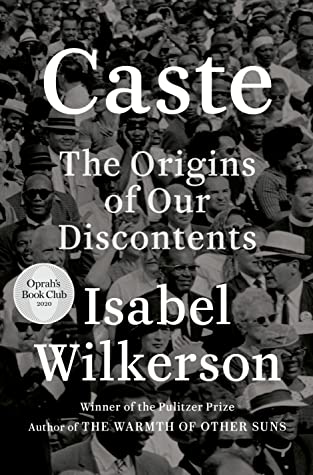
In her extremely well-received and reviewed 2011 non-fiction book The Warmth of Other Suns: The Epic Story of America’s Great Migration Isabel Wilkerson took a look at the great black migration from the Jim Crow South to the north in search of a better life.
Not entirely to their surprise, these southern immigrants found that there was plenty of racism is the North, as well.
In her new book, Caste, Wilkerson takes a closer look at the black vs. whites issues in America – past, present and possibly future.
Writing in a similar tome, Robin DiAngelo’s White Fragility has a fairly simple – yet disturbing thesis: All Americans, especially white Americans, are racist. Why? Simply because we are a racisty society and we’ve grown up in it.
Interesting.
But Wilkerson takes it to the next step: She equates racisn with actual hatred – active hatred, vs. the passive injustice of systemic racism.
She equates the 400-year-old chasm between whites and blacks – formerly slaves, now free – as a symptom of a caste system.
By that, she means (I’m greatly simplifying) that whites don’t necessarily hate blacks, it’s just that – in the fabrick of our society – blacks are assumed to be inferior in many ways. It’s not spoken; it’s just the way it is.
She compares and constrasts the American Caste with the centuries-old caste system in India (Brahmins down through the Untouchables [now Dalits]) and the short, terrifying caste that dominated Nazi Germany. This sudden change in mores led to the alleged superiority of Aryan and Nordic peoples, at the expense of the almost sub-human others (Romanians, homosexuals, and – especially – the Jews).
Caste is an extremely well-written book – an almost academic work of non-fiction (roughly 450 pages, including notes).
Its structure is interesting: While very precise and, as mentioned, scholarly, the books has short sections, self-contained, that offers personal insights by the author. These short sections are not integrated into the book flow, but are small, self-contained, all-italic asides where the professor steps out of the classroom as if to say, “I ran across this injustice personally. I was a reporter for…. Can you believe this still happens today, 400 years after th first slaves arrived on the East Coast?”
This is the book I expected White Fragility to be, but each serves it’s purpose.
White Fragility is a more accessible look at (the crappy state of) race relations in America; Caste drills in and shows how hideous this American Caste system is.
For example of the latter, Wilkerson writes of how the Nazis were fascinated with how America has subjugated its blacks, especially purity tests. In at least one southern state, having even one drop of black blood in you made you black. How to enforce that, back before DNA testing, is beside the point. The point was that the (white, of course) powers that be could make that impossible-to-prove determination. The Nazis marveled at how Americans had the cojones to do something so, well, arbitrary and get away with it. And these were the high ranking officials who were building ovens and gas chambers. Reminds one of the Salem witch tests.
Whether you buy into the premise of an American caste system or not, I expect Caste to end up on the Pulitzer and/or National Book Awards short lists. The books is dense but readable, and the subject matter is spot on for 2020, the year of Black Lives Matter.
I can think of only two other non-fiction books about the American black experience that transcend this one: Ta-Nehisi Coates’ Between the World and Me, and James Baldwin’s The Fire Next Time. That’s some heady company.
